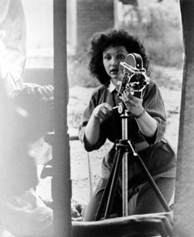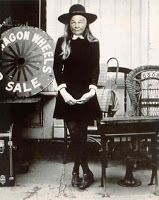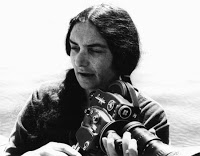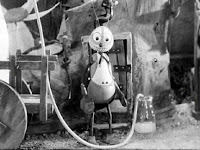Oddball Films Media
•
Apr 26, 2013
Oddball Films presents The Feminine Aesthetic, a program of vintage films by and about pioneering women artists and filmmakers; featuring groundbreaking animation, entertaining documentaries and breathtaking experimental works. We will begin the program with a trailer for The Seduction of Mimi(1972), Lina Wertmuller's breakthrough film (she went on to be the first woman nominated for a Best Director Oscar). Lotte Reineger made the very first animated feature and we celebrate her exquisite artistry with two of her most beautiful silhouette shorts, The Magic Horse(1953) and Galathea: Das lebende Marmorbild (1935). Maya Deren spearheaded the crusade for the poetry of experimental film and her piece Meshes of the Afternoon(1943), with its languid beauty and surreal suspense inspired countless generations of mainstream and avant-garde filmmakers. Woo Who? May Wilson (1970) is a genuine and ballsy portrait of a grandmother turned cheeky New York Art Star. Canadian animator Evelyn Lambert's Mr. Frog Went A-Courtin' (1974) is simultaneously beautiful, charming and slightly disturbing. The Lady from Sands Point (1967) is local legend George Kuchar's zippy portrait of mixed-media artist Betty Holliday. Hermina Tylova's Czech animated darling Ferda the Ant (1941) features the very first use of wire figures in stop-motion and some very cute ants. Plus excerpts from Underground Film (1970), an exploration into the work of influential filmmaker (and SF Cinematheque foundress) Chick Strand.
Date: Friday, April 26th, 2013 at 8:00pm
Venue: Oddball Films, 275 Capp Street San Francisco
The Magic Horse (B+W, 1953)
Lotte Reiniger, fascinated with Chinese silhouette puppetry, was the first to create a feature length animated film, the Adventures of Prince Achmed (1926). Her paper cut- outs are phenomenally intricate and lush, with dreamlike imagery and unlike any other form of animation. This short is from a series of fairy tales she completed in the 50’s, and is a further continuation of the Prince Achmed stories.
Meshes of the Afternoon (B+W, 1943)
One of the most influential works in American experimental cinema. Maya Deren's non-narrative work been identified as a key example of the "trance film," in which a protagonist appears in a dreamlike state, and where the camera conveys his or her subjective focus. The central figure in Meshes of the Afternoon, played by Deren, is attuned to her unconscious mind and caught in a web of dream events that spill over into reality. Symbolic objects, such as a key and a knife, recur throughout the film; events are open-ended and interrupted. Deren explained that she wanted "to put on film the feeling which a human being experiences about an incident, rather than to record the incident accurately." (MoMA)
Mr. Frog Went A-Courtin' (Color, 1974)
A gorgeous animation that truly gets to the heart of the inter-species strangeness that is the folk favorite “Froggie Goes A-Courtin'”. From the National Film Board of Canada, directed by Evelyn Lambart, and sung by Derek Lamb.
Woo Who? May Wilson (Color, 1970)
A portrait of artist May Wilson, former "wife-mother-housekeeper-cook" and a grandmother who, at age 60 after the break-up of her 40-year marriage, moves to New York City and discovers an independent life of her own for the first time. With humor and insight the film shows her acquiring new friends and a new self-image, and we watch her gain success as "Grandma Moses of the Underground."
Underground Film (1970, Color, Excerpt)
An exploration into ‘underground’ film through the eyes (and films) of California experimental filmmaker, Chick Strand, this documentary gives a close look into the life and work of one of the west coast’s (and Bay Area’s) most innovative independent filmmakers. Included among the interviews and footage of Strand working is a full-length version of her film, Anselmo, shot in Mexico in 1967. Lush color, layered images and intimate cinematography create an inimitable portrait of a musician friend and a tuba in Anselmo. Working in 16mm and Super 8mm, Chick Strand was one of a group of Bay Area filmmakers including Bruce Baillie, Gunvor Nelson, Dorothy Wiley, and Robert Nelson (to name a few) who established Canyon Cinema, San Francisco Cinematheque, and self published a journal of writings from and on filmmakers working in the area in the ‘60s and ‘70s. These filmmakers’ film work and efforts established a unique Bay Area community of distribution and exhibition for local film artists and have had an indelible impact on West Coast experimental and independent film aesthetics.
Ferda The Ant (B+W, 1941)
Based on the popular children's book, this darling stop-motion short features the titular protagonist facing off against a vicious arachnid while attempting to finish a hard day of work. When Ferda and his friend are caught in the spider's web, they must free themselves or be lunch. Made by one of the founding mothers of Czech animation, Hermína Týrlová, this innovative and beautiful film features the first use of wire-frame puppets in stop-motion animation.
The Lady from Sands Point (B+W, 1967)
A charming George Kuchar portrait of local artist, Betty Holliday. A grandfather of underground film, an inspiration to countless filmmakers like John Waters and Todd Solondz, George Kuchar never stopped creating films throughout his life. He made raunchy melodramas, goofy tornado-chasing diaries, and throughout the years, George was filming those artists around him that inspired him. The Lady from Sands Point is one of these portraits, and a tantallizing and entertaining one at that. He documents his friend and local artist, Betty Holliday, but in a way that only George could have done, with a zippy soundtrack and unique editing that seem to make the artwork dance across the screen.
Plus! The Trailer for Lina Wertmuller's socio-political romantic comedy The Seduction of Mimi.









